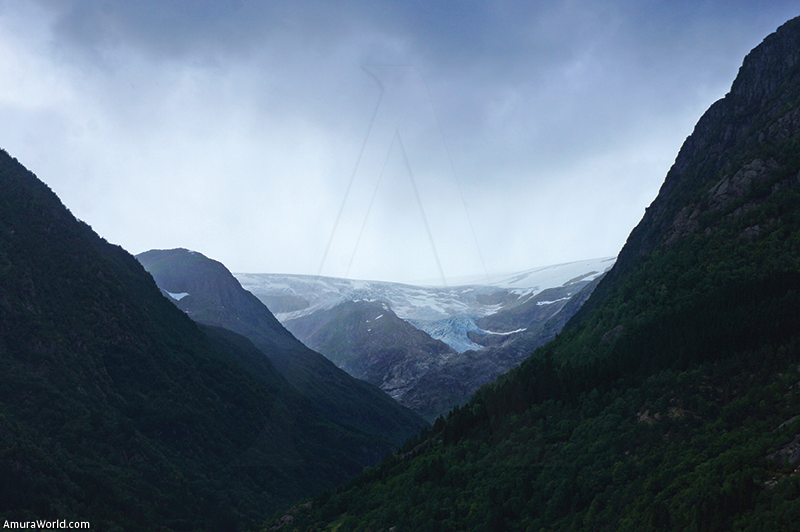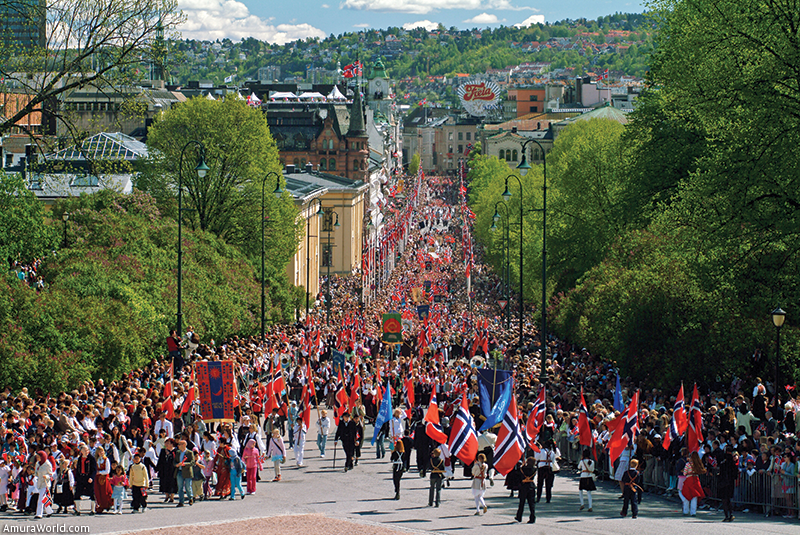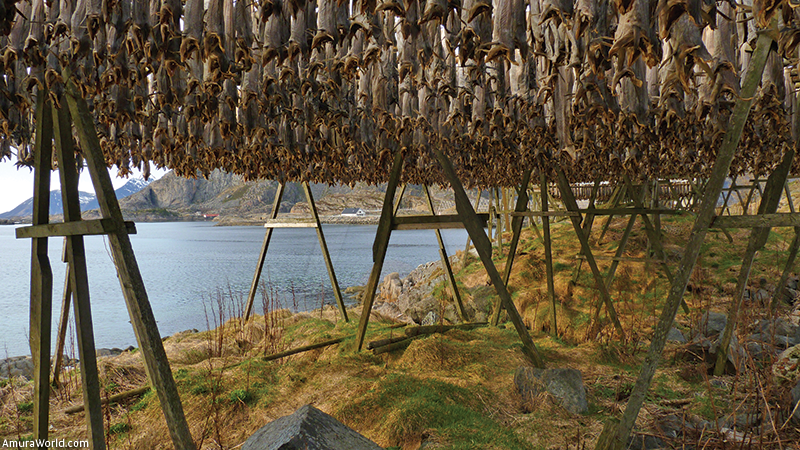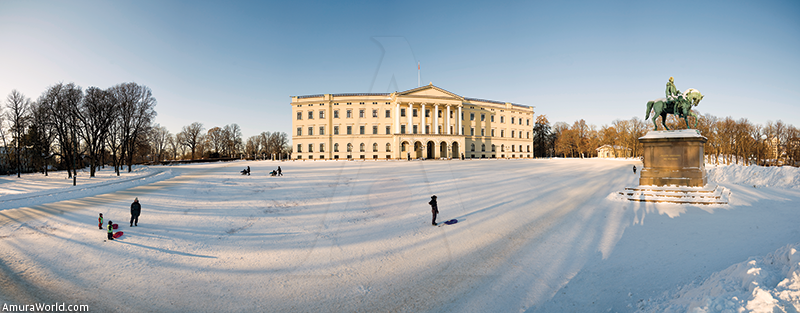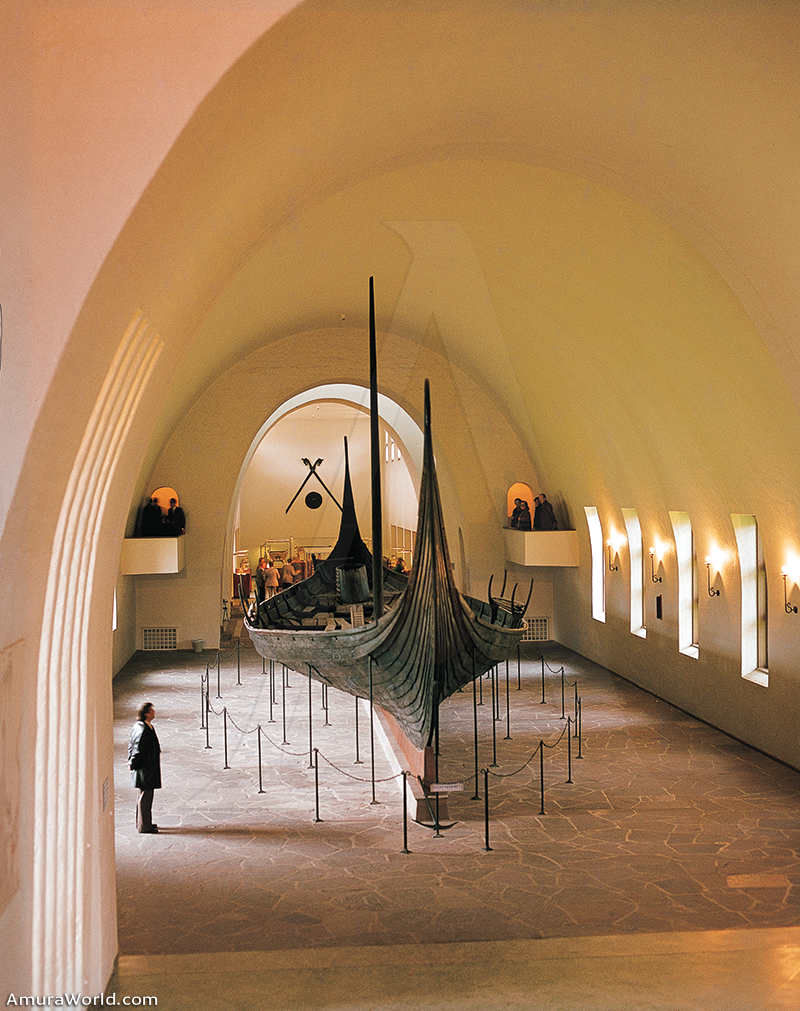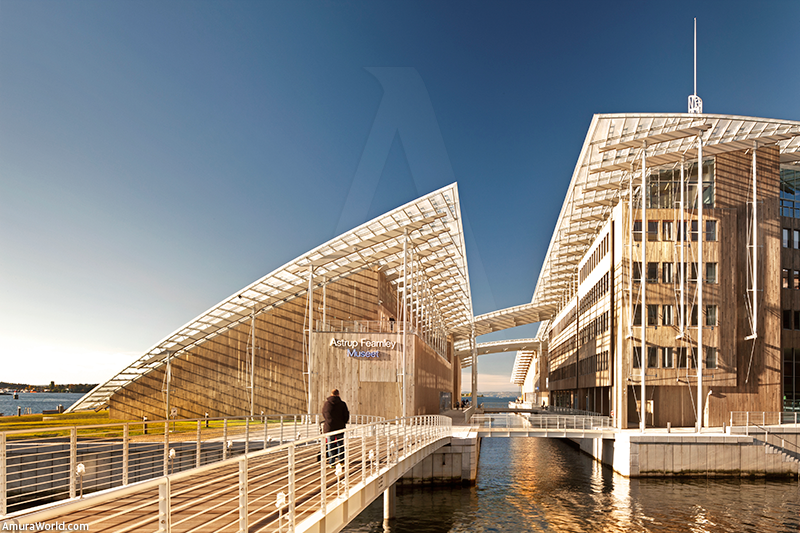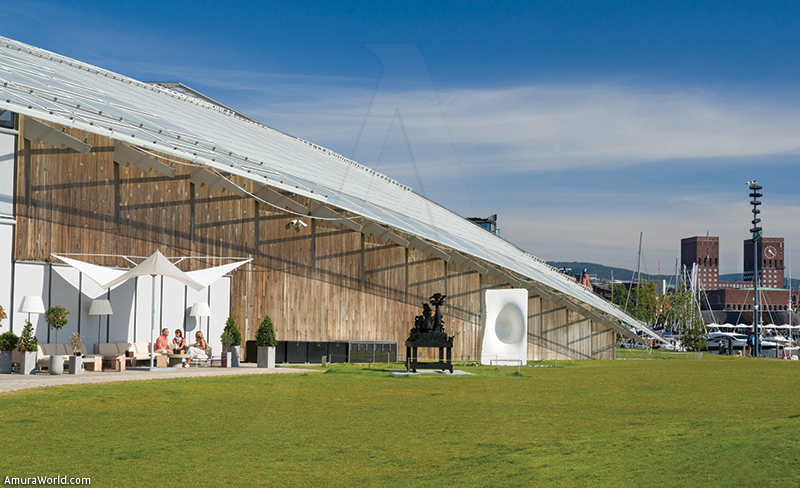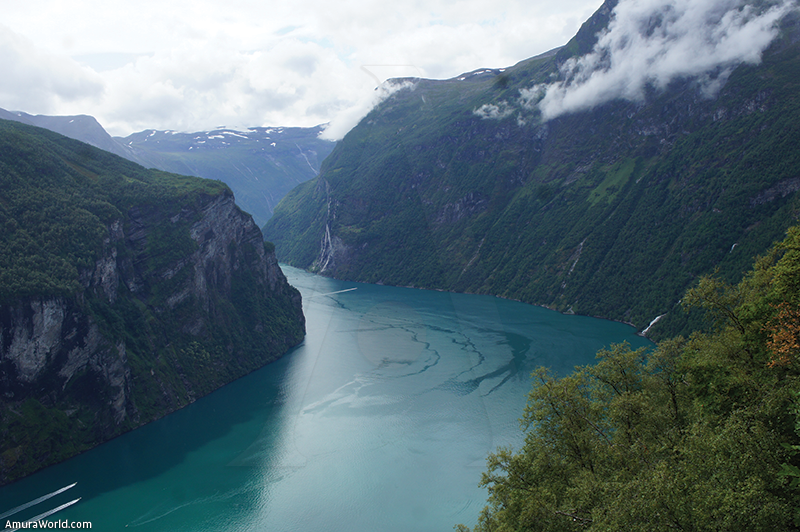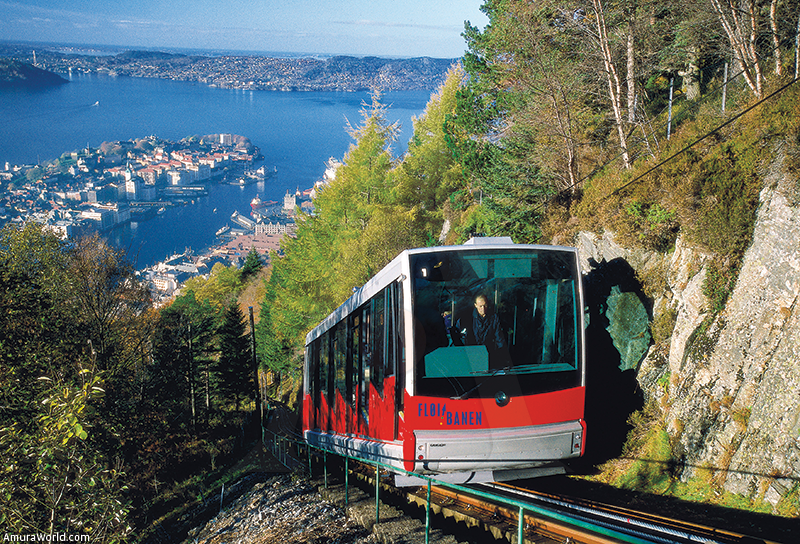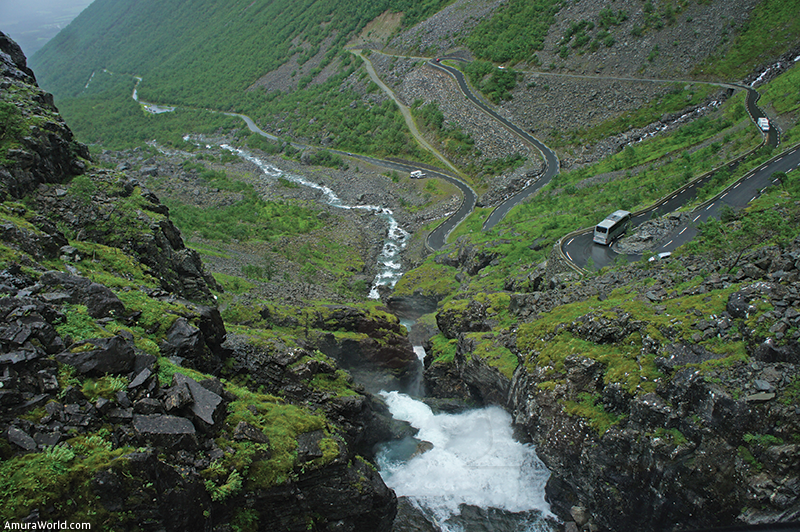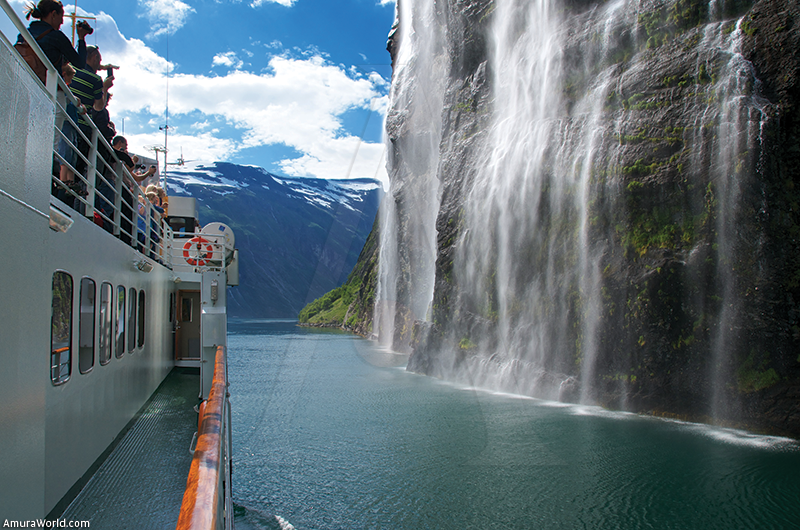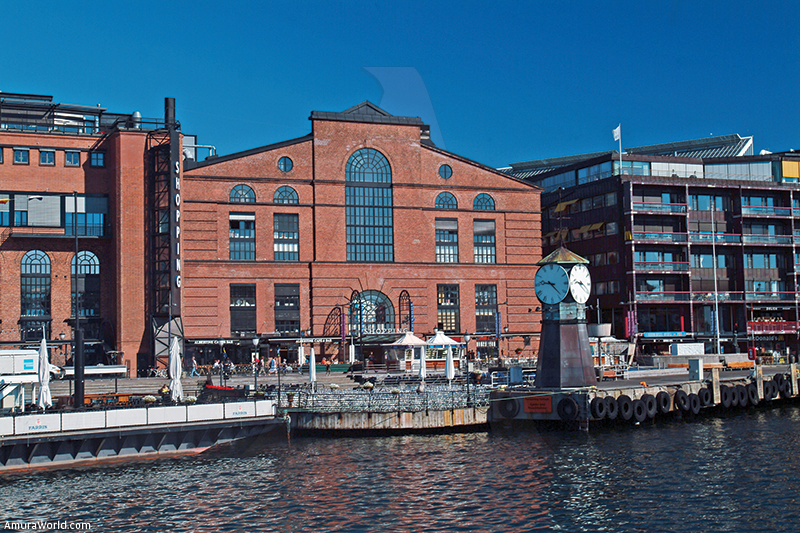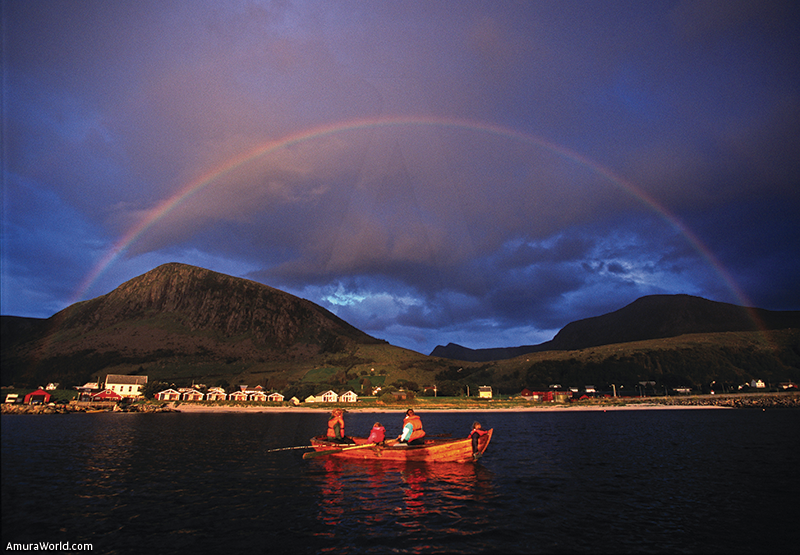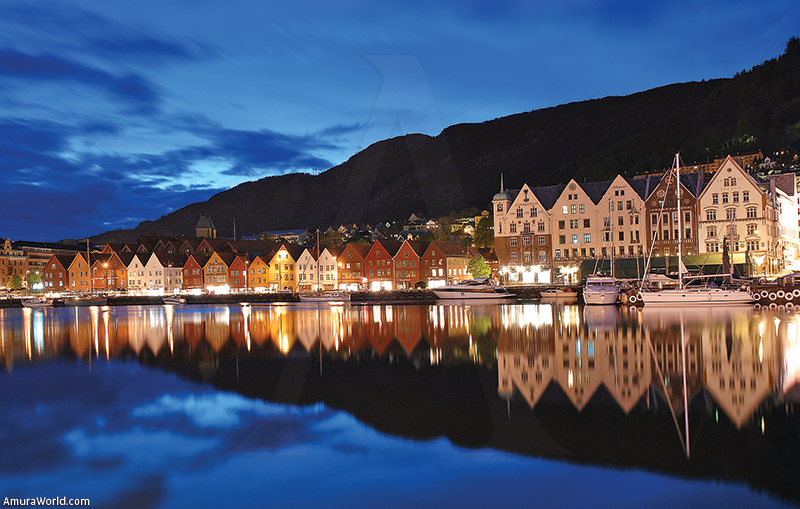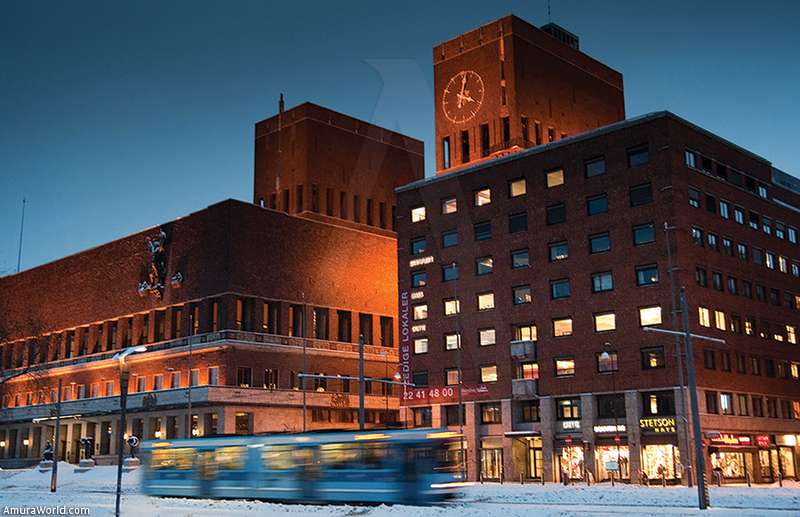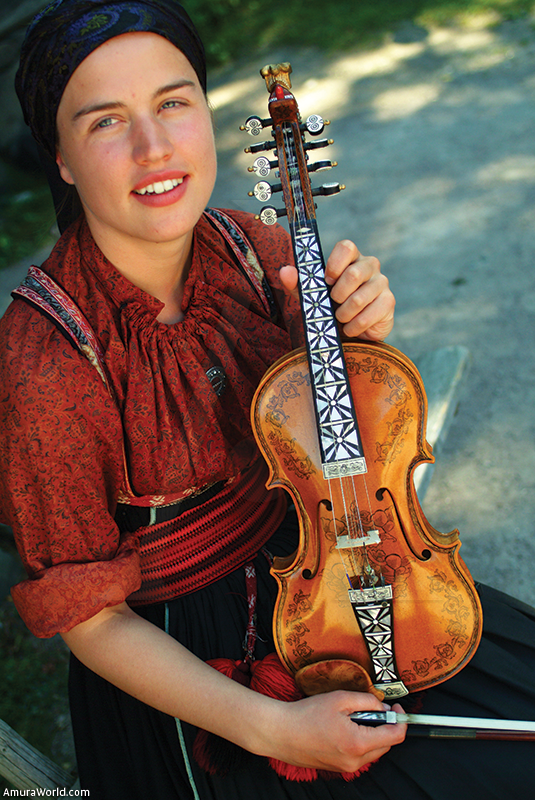Norway: The gateway to the Fjords
The kingdom of Norway has a healthy and rich economy, which combines the free market activities with the state participation, which generates low levels of inequality and corruption, translating into a wellbeing state for its population. At the same time, it is one of the main oil and natural gas producers of Europe, and where more than two thirds of the manpower works in the tertiary sector, being these two of the reasons why the Country outstands as one of the most developed Countries in the World.
The government controls key areas, like the petroleum sector, since Norway holds the 13th position in the world’s Hydrocarbon and gas reservoirs. The official Hydrocarbon Company of Norway, Statoil, established in 1972, has sales of 126,000 million dollar (md) and has a market value of 78,000 md.
National Day
After being part of the Danish Monarchy for 400 years, Norway signed its Constitutional Act on May 17th 1814, though the Independence actually took place until 1905, when it separates from Sweden. However, the historical date has remained officially as Norway’s Official Day, for it corresponds to a significant period, marked by the thoughts and revolutionary views that gave way to big national and political changes, being this the reason why it is also known as “The Year of the Miracles”.
In 2014 Norway celebrated its bicentennial of its Independence and the formation of its Constitution, also known as the Grunnlovsjubileet, act that was captured in the work of Oscar Wergeland (1844–1910), Riksforsamlingen på Eidsvoll 1814 (Eidsvoll Constituent Assembly1814), which is kept in the National Museum of Art, Architecture and Design.
So, on May 17th of this year, Norway had one of the most touching celebrations in its history, Oslo and Bergen captured the attention for being the most important cities, but also the smallest of towns, its embassies and consulates around the world, participated in the 200th Commemoration of the Promulgation of its Grunnlovsjubileet.
The festivities began with colorful parades of children who proudly carried their flags and banners, and the bands of music liven up the walking of the people who wore their typical National Garments.
In Oslo, the Capital City, approximately 100 schools and bands of music paraded and strolled through the city, walking by monuments and iconic buildings; in one of the balconies of the Royal Palace, the Royal Family could be seen waving to all who paraded. The procession ended in front of the City Hall, where thousands of citizens and visitors were reunited.
In Bergen, the main parade went out of the Torgallmenningen and ended in Festplassen, the parades passed through the central streets of the city. Once the parades finished, the concert and other activities enriched the feast throughout the day, amongst them was a rowing competition in Vågen. The celebrations ended with a huge display of fireworks.
The day was packed with activities which began at 7 am, and people would not be surprised by the noise when awakened by the bustle of the preparation for this big National festivity. This was a truly special moment to be in Norway and mix with the locals, for it was the way to live one of the most special traditions of any Country.
An old Sea-wolf
The History of Norway is strongly linked to fishing and the sea, though it also has important and famous River fisheries. Its inhabitants have earned their living fishing and hunting whales and seals. The fishing is a core element in the enterprises and industry of the Country, since in its waters you can find some of the richest schools of marine species in the world. The Norwegian coasts, as well as the Northern Sea, the sea of Barents and the Polar front, are areas of great fishing productivity, where the herring, the capelan, the codfish, the mackerel, the pollack, the haddock, the blue whiting, the maruca, the brosmio, the sprats, the fletán negro, the dog of the North, the Atlantic Redfish, and the Norwegian Flatfish are some of the main species of commercial capture.
Today, Norway is one of the main suppliers of food of marine origin, both, of fishing at sea and of aquaculture. The latter represent almost 50% of the fish exports of this Country. The aquaculture is based on the principle of sustainable exploitation of the live marine resources. According to the National Institute of Statistics, the herring, the capelin and the codfish (with 506,000, 155,000 and 470,000 tons respectively), are three of the main extractive marine products. While the Atlantic salmon –of which 1 million tons are produced worldwide, mainly in Norway, Chile, and the UK- and the Rainbow Trout, are the main species of the aquaculture industry, though a few varieties of codfish are being bred. Norway, along with Scotland, is the main breeders of this, with 10,000 tons per year. However, this variety is threatened by the overfishing, as are the flatten, the Dog of the North, and some shellfish.
Oslo: Dream Fjord
The age of Oslo is estimated in over a thousand years; on 2000 it officially celebrated its 1000 anniversary. However, it was until 1814 that Christiania became Norway’s Capital City when it became independent from Denmark. In 1925, the capital city changes its name and takes up again its original name, Oslo. It is located in the Oslofjord Fjord, which is a geographic accident of extraordinary beauty. It is a strait, or marine terrace, that gives way to an estuary formed in an ancient glacier valley. Oslo is considered a green city because it is surrounded by woods and has an ample natural piece of land.
The streets of this city during summer time are toured by the enchantment of the old trolleys and are protected from modernity, which guarantees you can enjoy a good day strolling by its pedestrian walkways.
This millennial city deserves a slow walking tour starting by the Karl Johans Street, which runs from the railroad Central Station to the Royal Palace and takes you to the new Opera House building, opened in 2008. This building was mainly built with white marble and has turned into a meeting center with a spectacular view of the Fjord of Oslo.
You can feel a special atmosphere in this city, with Street musicians, flowers and picturesque attractions. You can rest for a moment by the sea and find the energy to continue strolling and enjoy the Akershus fortress, with its Middle-age and Renaissance buildings which had an important role in various historical battles. Today, this fortress houses the Museum of the Resistance and is the seat of official acts.
The options for entertainment that the Capital has to offer are abundant: museums, festivals, concerts and expositions are some examples of these. Lots of them depend on the season in which you visit the city.
Some of the museums that are a must when visiting Oslo are: The National Gallery, the Munch Museum, and the Kon-Tiki Museum, which tells in pictures the story of the expeditions of Thor Heyerdahl. One of the most surprising museums is the one of the Viking Ships, where you can find three ships in excellent condition; it also exhibits the graphic story of its discoveries. One of them was under a hummock until two peasant teenagers began digging it out in 1879. The discovery brought an archaeological mission which continued with the rescue and determined that it was a funerary ship. You should also visit the Museum of the Nobel Prize of Peace, which is interactive and is focused on actual topics.
One of the most appealing strolls is in Aker Brygge, in this area you can enjoy a delectable shellfish lunch; on one side you have the Arkeshus Fortress with enormous cruises that sail through its bay, and on the other, dozens of restaurants with open terraces.
After your strolling of the dock, you reach the modern area of Tjuvholmen, where some people swim in the small beach; others enjoy a drink at the terrace of the Astrup-Fearnley museum, designed by the architect Renzo Piano. Cafes, restaurants, galleries and luxurious buildings coexist in this small island. Here what you can do is enjoy a salmon dinner in one of its terraces, which is an excellent way to start a lovely soiree. The moon comes up, becoming larger and luminous as the night advances. You can build a lovely memory of the summer nights of Norway while observing the masts of the sailboats in the fjord. One of the most luxurious and modern neighborhoods is the Bjørvika, an old industrial area, where residential buildings, offices, and intelligent buildings have been constructed. In this area the New Opera House and the Norwegian Ballet have opened their doors.
In Oslo, you can find various shopping malls where you can go shopping, but it is on the Akersgata Street where you can find the best stores.
Fjord City
The project called Fjord City Plan pretends to turn Oslo into a city totally renovated and transformed. What is intended is to take advantage of the fjord to give a new meaning to the Norwegian Capital City, integrating the spaces of the distinctive steps, with long term action plans based on its social and cultural structure.
The ambitious plan contemplates three main things: Green Oslo, which supports the environment, Red Oslo, dedicated to the human relations, and Big Oslo where the topics are the population diversity and density. These scenarios converge in the idea of the European Green Capital, the city as an accessible and meeting space, establishing relationships through a potent mobility core extended through the fjord.
The trolley and the tunnel, for example, are the proposed solution for the mobility problems in the port, which is the main stop preventing the integration and social contact. The studies of mobility allow the government to develop connectivity strategies and usage of the land, understanding that both directly influence the fluidity and attractiveness of the weave.
Bergen
One of the most typical tours in Norway is Bergen, the second largest city of the Country, with a history that goes back to the XI century. To walk its squares, with the warm summer weather and in the afternoon light is enough to make your day a magnificent one. Surrounded by seven hills and seven fjords, it has a singular flavor and just as you believe that there is no other sight as beautiful as this, a new one appears to challenge you. Bergen means “The Mountain” and was founded in 1070 on the Vågen coast by King Olaf III.
Its architectural distinction, accentuated by the mid afternoon sun and the spectacular natural location, have had this city to be declared World Heritage. In the summer, it is possible to enjoy one of the international attractions, the Tall Ship Races, when you can see dozens of mast ships or tall ships, which come from different Countries. The sky is a deep blue and the temperature is over 30°C, on the streets you can find places to buy sausages, ice cream, fruit, and all kind of delicacies. Thousands of visitors take the walkways by the dock, where you can appreciate the old multicolored houses, made of wood, inherited of the XIV century Bryggen, which instead of keeping fish or merchandise –like in the old times- they house art collections and cultural centers.
To visit the fish market and enjoy fresh shellfish can be very interesting.
As well as strolling in its medieval neighborhood that comes from the days in which the port was an important center of commerce.
Other activities that the city offers are theater, dance, sports and concerts of one of the worlds oldest symphonic. Something you cannot skip doing in Bergen is take the funicular to Mount Fløyen, where you can see all the city and the sea, walk through the woods or kayak in the pond at the top of the mountain.
This city is also known for being the entry to the fjords. Even if you have little time, take a tour to visit them and enjoy the majesty that you could experience in an expedition to the Norwegian Coast.
Bergen’s population carries a lot of students, and this is why it is known as one of the cities called Education Centers.
Driving by the fjords
To rent a car and drive by the highways of Norway is one of the ways to get to know places and admire sights that possibly exist only in dreams. One of the best routes is towards Lofthus, where the largest route means exquisite panoramic views. It is possible to make a stop and enjoy the Steinsdalsfossen cascade with a height of 50 m offering the attraction of you walking behind the waterfall.
The fjords are narrow sea entries that were formed during the ice age when the glaciers contracted. They exist only in a few Countries and the highest concentration is in Norway, where due to its mild weather there is abundant vegetation. To drive by the fjords is a challenge, sometimes the road narrows to a one line, though the road is perfectly well planned. Depending on the route, sometimes it is better to cross the water straits using the ferry, after which you can pick the car up again. If you have decided to travel by car, it is important in winter time that you check whether or not the highways are opened to enjoy this trip to its maximum.
Stave Churchs
The Stavkirke, as the old medieval Christian temples built with wood are called in Norway, better known as Stave Churchs, are maybe one of the most beautiful pieces of Christian architecture in the world.
Amongst them the temple of in Luster outstands. Built in 1150, was declared World Heritage in 1979 by the UNESCO.
The story tells that it was built for a powerful family and that its builders decided to move the aesthetic in stone to wood, managing an exceptional, elegant and slender reproduction by using several levels of roof. The interior of the building is decorated with animal motifs and with representations of beings from the Nordic Mythology.
The largest Stave Church in the Country is Heddal, in the Telemark County, which has three naves with an apse and a portico. The temple, dedicated to the Virgin Mary, was built in the XVIII century. In its interior it is worth mentioning the Chair of the Bishop which is richly decorated, the altar and the Wall paintings come from when it was built. According to the local legend, it was built in three days by five peasants. It has been subjected to various restorations in the XIX and XX centuries. It is still functional and is constantly used for weddings, as well as for the traditional Sunday services.
There are several types of wooden churches, but all are conformed by a skeleton made of wood planks as walls, leaning on sills. Besides, the decoration of the stavkirker mixes Christian designs with pre-Christian Viking, like the intertwined dragon motif. The wooden doors and their finishing are wonderfully carved.
Where you can find happiness
The Net of Solutions for the Sustainable Development of the United Nations (UN) set Norway in second place after Denmark and before Switzerland in its Worldwide Happiness Report of 2013. This net defines happiness as a changing emotional state, but just the same, as an indicator of the degree of conformity and wellbeing of people. Some of the data that indicate Norway as one of the happiest Countries are, for example, that the majority of its inhabitants show a long and healthy life (the average life expectancy is 81 years old), that they have knowledge (the average schooling is almost 13 years) and a dignified level of life, due to, amongst other things, the average per capita income that, according with the World Bank (WB) in 2013 was of 100,808.50 dollars.
Some of the indicators that are taken into consideration when deciding the level of happiness of a particular Country are based on statistics, such as the divorce rate, or the life that its people carry out in the community; in other words, how much the people relates to the city where he or she lives. The material wellbeing is also taken into consideration, taken as IBP per capita, the unemployment index (around 3%), the political stability and the safety in the cities and in the Country itself; the weather and the geography of the place; the civil rights and the freedom of creed, the gender equality, as well as a peaceful relation with other Countries, in other words, that they are not living in a latent state of war.
Happiness and the Environment
Norway also stands for being one of the Countries that is most worried with caring for its environment, which includes, just to mention an example, the usage of alternate fuels. One of the most important documents to define sustainability is the Brundtland report, draw by Norway’s ex-minister Gro Harlem Brundtland, as well as by a group of experts. Today, this Country has become a leader in the topic, of which others take example of the environmental topic. Another parameter that the UN utilizes, as well as different instances, is the degree of corruption that the members of the government and other public servants may have. Regarding this issue, the International Organization for Transparency, in its 2013 ranking, set Norway in the fifth position in a list of 175 Countries.
Oslo is a city that surprises for its cultural and religious diversity; you can find women with burkas or wearing miniskirts, you can find a bit of everything…
Bergen offers numerous international musical and cultural events throughout the year.
Text: Daniela Becerra ± Photo: Daniela Becerra / Asgeir Helgestad / Artic Light AS / visitnorway, Norwegian Visual Artists © Society / SXCHN / LNGN ©ASLAK TRONRUD / DAMIEN FRIZ / WLS / WILLIAM CHO / K SKYE / GETTY IMAGES / PXZARD / BP / hostaff


